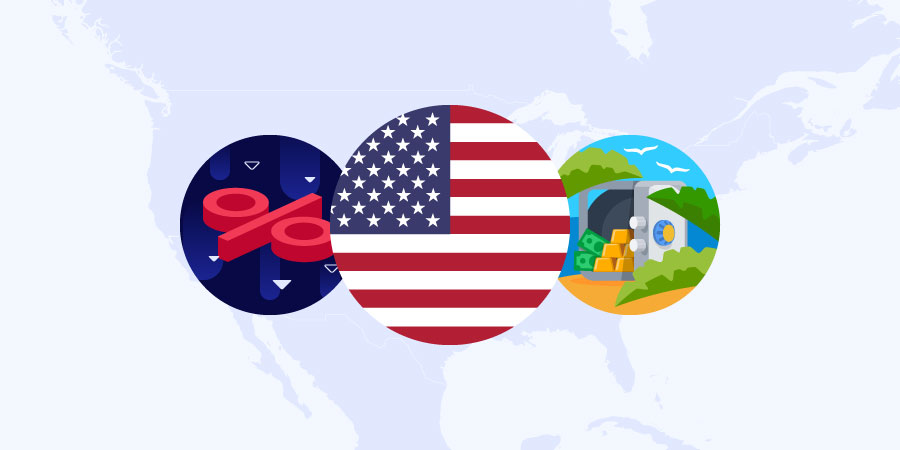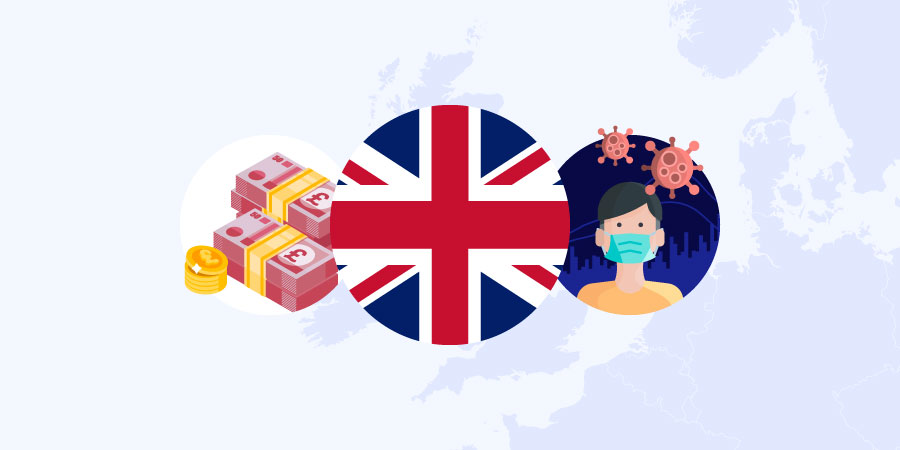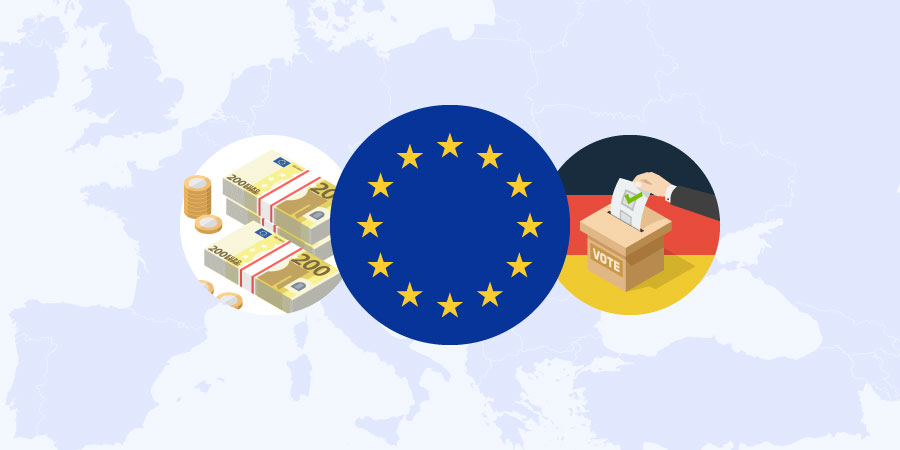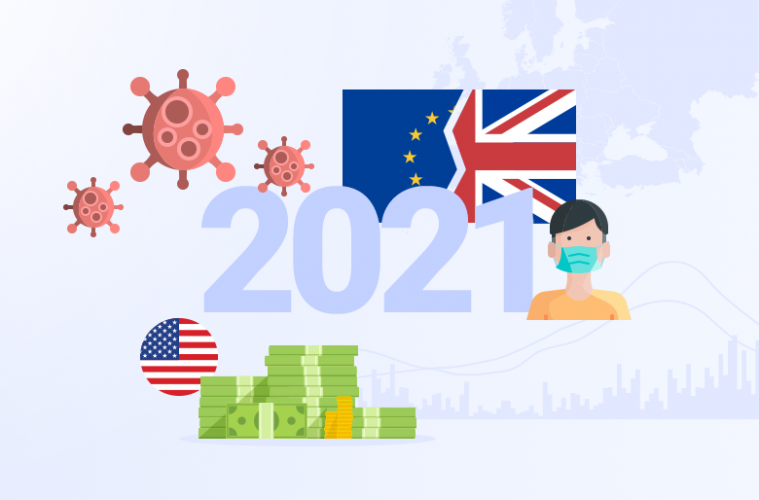2020 was a year full of surprises. The Covid-19 pandemic presented many challenges, causing much of global economic activity to come to a halt. As 2021 gets underway and news of a vaccine fuel market optimism and hopes of a faster global recovery, we wanted to share some of our insights with you on three of the most widely traded currencies; the dollar, the euro and the pound.
The Dollar

A great way to track the performance of the dollar is through the US dollar currency index, also known as the DXY . This provides a live view of how the dollar is performing against a backdrop of currencies. Over the last 12 months, the DXY has dropped 13.4%, as the dollar continues to fall out of favour with the markets. One of the main drivers, which will likely be a continued theme in 2021, is the developments of various vaccines. The USD, as a reserve currency, acts as an insurance policy to the financial world in troubled times. However, the development of the Covid-19 vaccine and the perception on how the US has been impacted by the virus has resulted in a transition away from the dollar and into other safe haven options. This cycle also includes the movement from safe-haven to risker assets, when the market deems it to be worth the reward. Both of these cycles require selling of assets and can fuel a weaker dollar, so it will be important to understand how the financial markets are reacting to the effectiveness of the various vaccines in 2021.
The US election did not provide a huge amount of market volatility, but the development of new policies, as well as funding and programs under the new president could have an impact in 2021. The current market focus is on the next Covid-19 relief package and how it will impact the US economy. Although not an exact science, soaring stocks are fuelled by a weaker base currency as those businesses benefit from exporting profits. During the Federal Reserve’s most recent meeting, they stated that they see a long period of accommodative monetary policy which has translated into some all-time high prices for US indexes. The Fed’s current stance on monetary policy may change, but for the foreseeable future they have maintained a firm view that interest rates are unlikely to move. There is still the wildcard outcome of seeing negative rates, something very experimental in the banking world, that remains a possible threat – interest rate hikes tend to support a stronger dollar, so negative rates could be deemed as a trigger for a weaker dollar. You can see their scheduled meeting times by visiting the Federal Reserve website.
Key factors influencing the US dollar:
- Interest rates
- Safe haven status
- Fed monetary policy
The Pound

Before exploring the path the pound must tread in 2021 to have a more prosperous year than 2020, it is worth noting that one of the key millstones that has hung around sterling’s neck for four and half long years is now removed – Brexit. The trade deal was struck on Christmas Eve, and since then, the pound has now breathed a huge sigh of relief, pushing GBP up across most major currency pairs. A question we have been asked many times by clients is, why hasn’t sterling now exploded upwards? Putting aside the more detailed analysis of future trading arrangements yet to be agreed – the answer is twofold: Covid-19 and negative interest rates.
The first and most obvious obstacle the UK needs to navigate to ensure the pound can really push on, is that of its Coronavirus response and vaccination programme. The pound has remained supported despite the advent of a third national lockdown; chiefly down to the fact the UK had the most vaccines on order per person globally when in development; and as of the 8th of Jan, the UK now has three vaccines approved for use. This puts Britain in a fantastic position to push ahead of its neighbours in the race to get its most vulnerable citizens inoculated, which in turn, will hopefully get the UK out of lockdown and rebounding economically – pushing the pound up with it.
The other hurdle that will need to be jumped is that of avoiding negative interest rates from The Bank of England. As a general rule of thumb, when interest rates are cut, the currency is less appealing to hold globally and usually depreciates in value. Negative interest rates on the other hand are a very different beast. Although the 0.10% currently maintained by the BoE remains, the fear now is that damage done by the third lockdown is likely to force the hand of the Monetary Policy Committee to cut again, to flat or beyond. Bearing in mind importance of the race to vaccinate and escape lockdown mentioned earlier; the need to avoid negative rates is arguably even more critical – being charged to hold pounds in your bank account will never sound good to anyone.
Key factors influencing the pound:
- Interest rates
- Bank of England monetary policy
- Covid-19 economic response
The Euro

Following a lengthy four-and-a-half-year divorce from the UK, the Eurozone has now parted ways with the third largest European economy and is free of continuous speculation to continue as the world’s largest trading bloc. After what was a turbulent period, the GBP/EUR rate crumbled by up to 20% since the 2016 referendum.
Looking into 2021, economists will have their eyes on a key election which is due to take place within the third quarter of the year. In September, Angela Merkel is due to step down as Chancellor of Germany, the largest economy within the European Union. After holding the position for 15 years, Mrs Merkel is seen by many as the continent’s most powerful leader. France will also head to the polls on a regional level at some point in late spring or summer. Whilst this will not have an immediate impact on the President, the results will give an insight into opinions heading into the presidential race in 2022.
At the last meeting of the European Central Bank in December 2020, it was announced that the bank will be further extending its quantitative easing package by €500 billion. Taking the total stimulus package will now total €1.85 trillion. One big objective for the central bank heading into the new year is to become a global leader in driving climate change. Fossil fuel and hefty carbon emitting companies could be overlooked, as the bank moves away from the typically neutral standpoint, of purchasing bonds across the overall market.
After once being labelled as the world’s Covid epicentre, by the World Health Organisation, the European Commission has moved to secure up to two billion vaccines, with both Pfizer/BioNTech and Moderna drugs now authorised for administration. Vaccines will start to roll out within the first quarter of the year, with a hope from many within the Union that free movement of the population can once again continue.
Key factors influencing the euro:
- ECB monetary policy
- The German election
- Safe haven status
Authors

Alistair Hutson, Senior Relationship Manager

Joshua Haden-Jones, Senior Relationship Manager

Jack Nicholls, Relationship Manager
| Speak with our friendly staff to see how you can receive the best rates on your investments | |
|---|---|
| Contact us via phone, email, or live chat |
Whilst every effort is made to ensure the information published here is accurate, you should confirm the latest exchange rates with WorldFirst prior to making a decision. The information published is general in nature only and does not consider your personal objectives, financial situation or particular needs. Full disclaimer available here.


